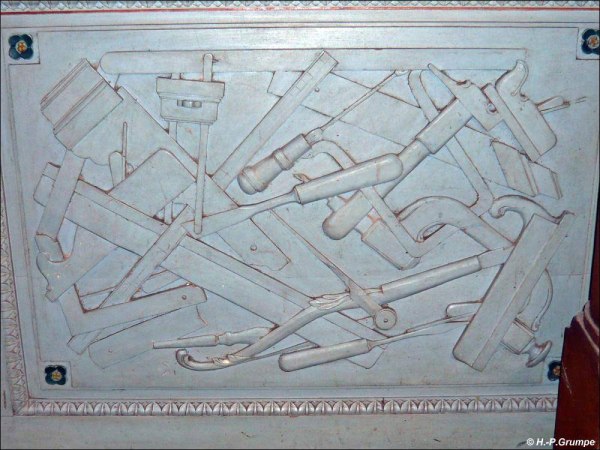After you make a bunch of these 16th-century squares, two things become apparent.
1. Gee, these squares are handy, compact and easy to use when scribing lines on work that has been trued up.
2. Gee, these squares are a pain to true up because of all the end grain in the handle.
In fact, truing them up is the only difficult thing about making them. If I’m careful when I build them, then they come out of the clamps dead square and ready for a coat of finish. If they aren’t square, it usually takes me about 15 to 20 minutes of fussing around to get them square. You have to bevel off the moulding profiles on the handle with care so you don’t spelch the corners when truing things up.
The best plane for this task is a heavy jointer, which has the inertia to plow through 2” x 2” of end grain without complaining.
When truing up my fifth or sixth square, I thought about making the blade a little wider than the handle – like an 18th-century wooden try square. That would make the square a piece of cake to true up – no end grain. But none of the images in my library showed that detail.
Jeff Burks to the rescue.

In any case, the Melencolia square shown in the sculpted grouping of tools has its blade wider than the handle. Score.
If you’d like to investigate this church some more, Jeff provided these links. Here’s the set of photos where that original image came from. You can read more about Biertan here. Warning, it will make you want to visit. And so don’t read these travel blogs on Biertan here and here.
So I have one more square to make. Then I really have to stop fooling around with these squares and start building a big piece of casework on my calendar.
— Christopher Schwarz
P.S. I posted a couple of SketchUp drawings of these squares on my blog at Popular Woodworking Magazine. Here’s the link. Other stories in this too-long series:




I notice the carving also has a 45 degree version.
Will you be making these also?
“The best plane for this task is a heavy jointer,…”
I assume you mean something like a Stanley #7 or #8, and not something like a Grizzly or Powermatic.
Indeed. A machine would make a mess of these.
B17 or even something a bit lighter, the B25.
Too long!? It’s been a fascinating series. Thanks for the research and insight you provide. Cheers.
There is a major bonus in the engraving today from the end of a church pew. Shown in the bottom right-hand-corner is the nicest shoulder marquetry knife I’ve ever scene with the acanthus leave decoration just above the hand grip and a foliate carving further up. Whoever claimed the Gods were only in the Heavens.
Here are some fancy ones in real life from Skokloster Palace in Sweden. Photo courtesy of Bengt Nilsson.
https://lostartpress.files.wordpress.com/2014/06/shoulder_knives.jpg
Is that one of the squares hanging down between the first and second knife in the picture, kinda looks like it to me, but then I have been wrong before.
Both squares in the picture seem to be proud of the stop. so that they may be trued with out touching the end grain?
Need to read more carefully, not my strong point!! my apologies ..
score for sure. did they make them with a sliding dovetail at all? would that get wonky after awhile?
I have not seen one with a sliding dovetail, but it would work quite well. So give it a try!
I had the same question. i wondered why no comment on that device. It would be great for picture frames, etc.
I don’t normally encourage animal cruelty…but feel free to keep beating this dead horse. Fantastic stuff Chris!
So, thinking of visiting Romania? 😀
Did you know about Romanian woodworking culture? It’s amazing. “The Civilization of Wood” is what a Romanian historian calls it. If _Woodworking in Estonia_ is a classic, a book about Romania would be a nuclear bomb.